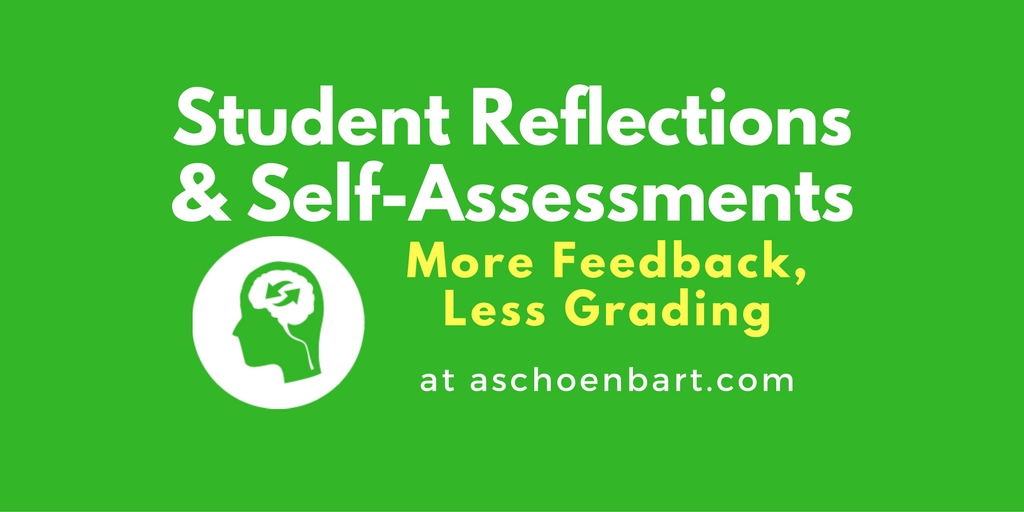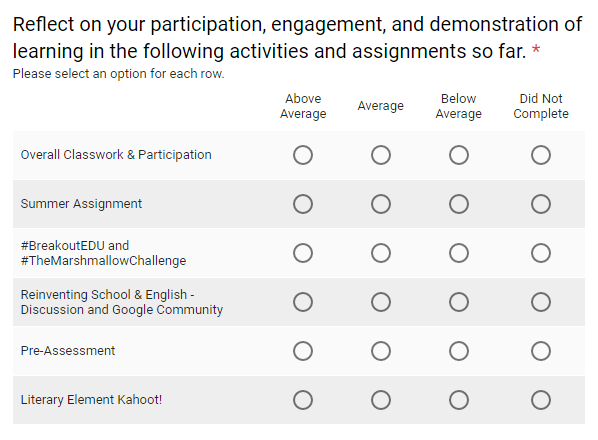Student Reflections & Self-Assessments


Instead of spending my time on grading, I want to use it to give stronger feedback, help students grow, and build better relationships. These are ideas I’ve mentioned over and over in the past few months of writing, and I’m ready to bring them to practice.
I’ve explored research and articles on the value of students’ self-assessing and reflecting on their progress, and decided to start the second week of classes with students making arguments for their own grades.
In the long run, I want to move away from traditional grading but am still trying to find balance as I learn more about effective systems and practices. My school uses numeric grades, and for now, I’m going to make that work for me. But instead of using grades as power, I want them to represent learning and growth as best as possible. I always used rubrics, but I’ve decided that to make them mean more to students and to learning, the students need to be the driving force in that process.
In the past, I’ve found great success in student reflection, metacognition, and self-evaluation throughout my Genius Hour projects. I share that work in What Students Think About #Genius Hour Part 1 am ready to expand this idea throughout my classes.
The Reflection Form
Click hereto copy the form if you’re interested. Here are the directions I provided:
The most meaningful and long-term learning occurs with specific feedback and opportunities for growth.
Research shows great improvements in student achievement when students monitor their own progress and self-assess their learning.
Grades communicate what you know, what you can do, and what you have learned. How can you demonstrate your new learning and ideas? Consider the fundamentals of English (reading, writing, speaking, etc.) along with the 4 Cs of 21st Century Learning (critical thinking, collaboration, communication, and creativity.
Use this reflection form to reflect on your progress so far and make an argument for your grade for the first two weeks of English 10.
A copy of the form results will be send to your OHS e-mail address. You can finish this form by clicking the link to edit from that e-mail.
Using Google Form’s settings, I restricted the form to my domain, collected usernames, and send an automatic confirmation receipt. I love this last feature because it also provided students with a link to edit their responses, too.
Tools and ideas to transform education. Sign up below.

In part one (above), I was looking for some data about students’ overall understanding and progress. I was especially interested in how their perceived their contributions to class so far. In the future, I want to generalize these ideas to create a form that students can use throughout the year with minimal editing. Or even better, I’ll have students describe the learning activities for the rows.

In part two, I ask students to grade themselves and justify their choice. I still don’t love the numeric grade aspect, but I do love the metacognition and reflection they showed in their writing here. I like these questions but will likely tweak my description of student expectations. I’d love some ideas for this part.
Moving Forward
The student responses for this form were incredibly thoughtful and thorough. They showed real reflection, and seemed honest and accurate, overall. Next week, I’ll share some of the big ideas from their reflections along with their feedback on the reflection process as a whole. This week, students are working with their summer assignments through literary analysis, discussion, and group work. They will reflect and evaluate this work, too.
Once it comes to larger and summative learning, I plan to work hard on effective peer and self-assessments, so that students can help each other grow. Then, I can continue to give feedback that matters, while demystifying the power of the grade.
How do you use reflection and self-assessment in your teaching? What suggestions do you have to improve my work-in-progress? Please share in the comments or on Twitter @MrSchoenbart.
cross posted at www.aschoenbart.com
Adam Schoenbart is a high school English teacher, Google Education Trainer, and EdD candidate in Educational Leadership. He teaches grades 10-12 in a 1:1 Chromebook classroom at Ossining High School in Westchester County, NY and received the 2014 LHRIC Teacher Pioneer Award for innovative uses of technology that change teaching and learning. Read more at The SchoenBlog and connect on Twitter @MrSchoenbart.
